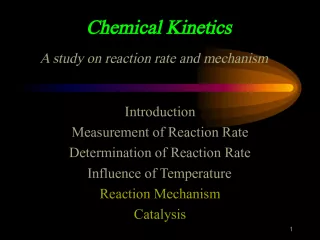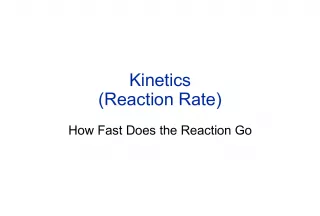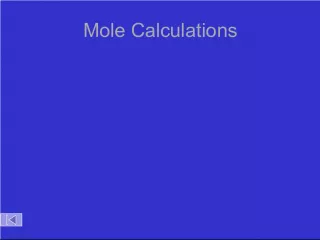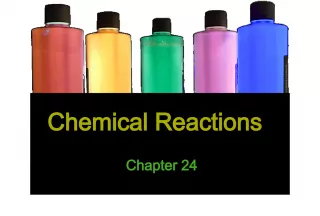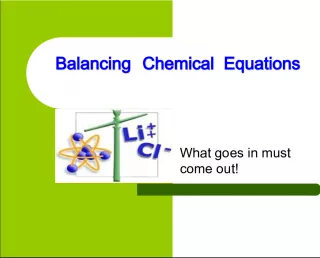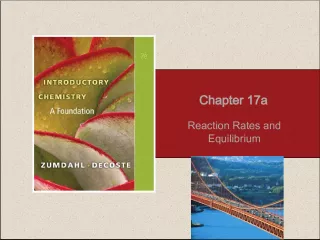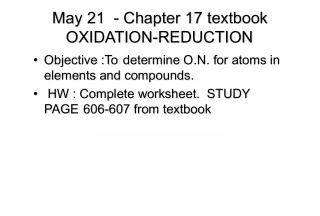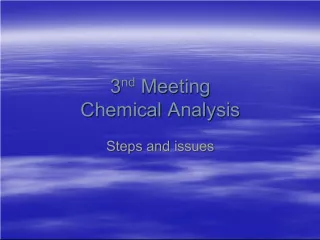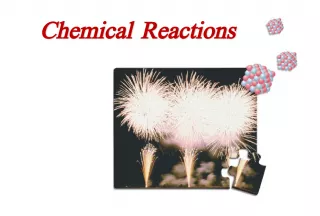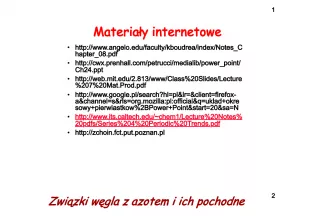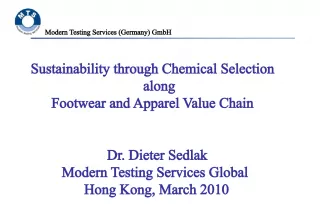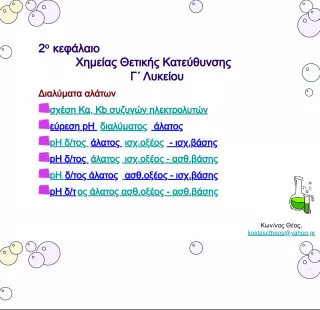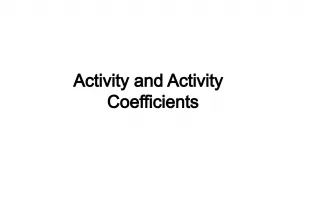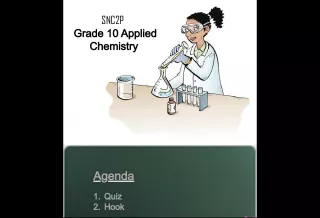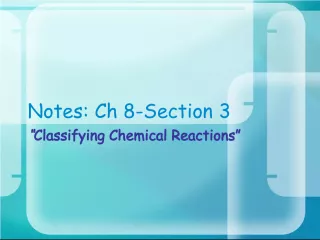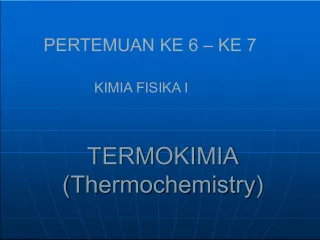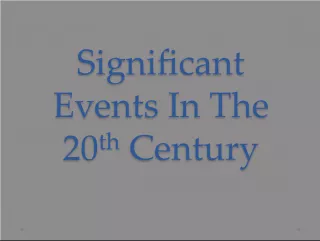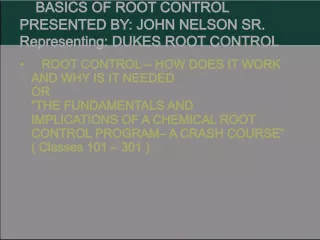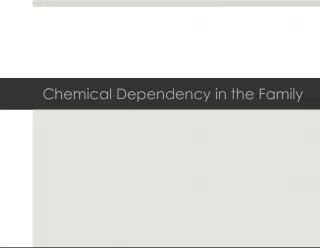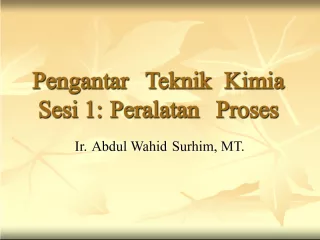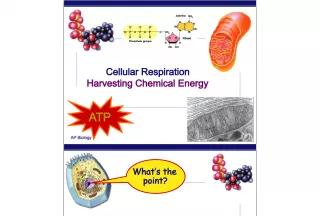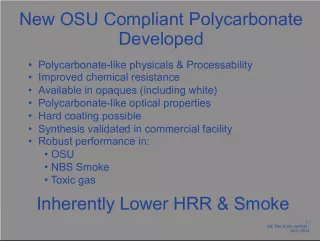Stoichiometry Calculation for a Chemical Reaction
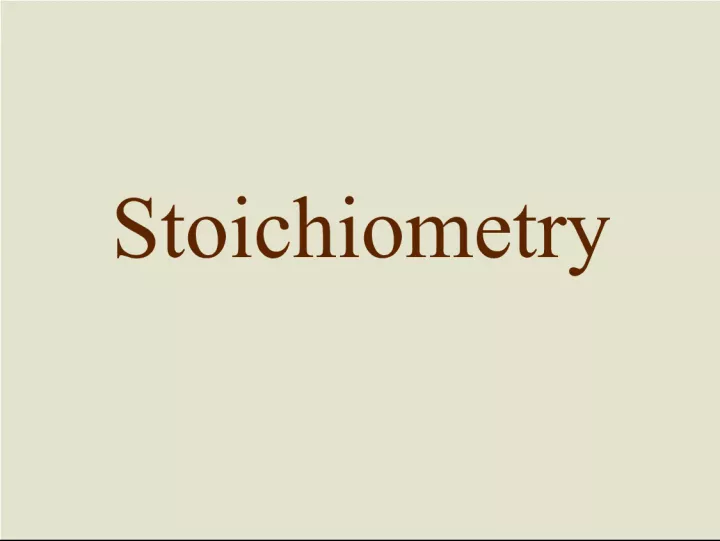

This article discusses stoichiometry calculations for a chemical reaction involving the conversion of 4NH3 and 5O2 into 6H2O and 4NO. It explains
- Uploaded on | 5 Views
-
 violagarcia
violagarcia
About Stoichiometry Calculation for a Chemical Reaction
PowerPoint presentation about 'Stoichiometry Calculation for a Chemical Reaction'. This presentation describes the topic on This article discusses stoichiometry calculations for a chemical reaction involving the conversion of 4NH3 and 5O2 into 6H2O and 4NO. It explains. The key topics included in this slideshow are . Download this presentation absolutely free.
Presentation Transcript
Slide1Stoichiometry
Slide2Consider : 4NH3 + 5O 2 6H 2 O + 4NO • How many moles of H 2 O are produced if 0.176 mol of O 2 are used? • How many moles of NO are produced in the reaction if 17 mol of H 2 O are also produced? 6 mol H 2 O 5 mol O 2 x Stoichiometry questions (1) # mol H 2 O= 0.176 mol O 2 0.21 1 2 mol H 2 O = 4 mol NO 6 mol H 2 O x # mol NO= 17 mol H 2 O 1 1 .33 mol NO = Notice that a correctly balanced equation is essential to get the right answer
Slide3Consider : 4NH3 + 5O 2 6H 2 O + 4NO • How many grams of H 2 O are produced if 1.9 mol of NH 3 are combined with excess oxygen? • How many grams of O 2 are required to produce 0.3 mol of H 2 O? 6 mol H 2 O 4 mol NH 3 x Stoichiometry questions (2) # g H 2 O= 1.9 mol NH 3 5 1 .4 g H 2 O = 18.02 g H 2 O 1 mol H 2 O x 5 mol O 2 6 mol H 2 O x # g O 2 = 0.3 mol H 2 O 8 g O 2 = 32 g O 2 1 mol O 2 x
Slide4Consider : 4NH3 + 5O 2 6H 2 O + 4NO • How many grams of NO is produced if 12 g of O 2 is combined with excess ammonia? 4 mol NO 5 mol O 2 x Stoichiometry questions (3) # g NO= 12 g O 2 9.0 g NO = 30.01 g NO 1 mol NO x 1 mol O 2 32 g O 2 x
Slide5DO NOW- Balance• Al + HCl AlCl 3 + H 2 • N 2 + H 2 NH 3 • Al + O 2 Al 2 O 3 • C 3 H 8 + O 2 CO 2 + H 2 O • 2Al + 6HCl 2AlCl 3 + 3H 2 • N 2 + 3H 2 2 NH 3 • 4Al + 3O 2 2 Al 2 O 3 • C 3 H 8 + 5O 2 3CO 2 + 4H 2 O
Slide6Limiting Reagents: Limiting Reagents: • Do two separate calculations using both given quantities. The smaller answer is correct. Q - How many g NO are produced if 20 g NH 3 is burned in 30 g O 2 ? 4NH 3 + 5O 2 6H 2 O+ 4NO 4 mol NO 5 mol O 2 x 30 g O 2 2 2 .5 g NO = 30.0 g NO 1 mol NO x 1 mol O 2 32.0 g O 2 x 4 mol NO 4 mol NH 3 x # g NO= 20 g NH 3 3 5 .3 g NO = 30.0 g NO 1 mol NO x 1 mol NH 3 17.0 g NH 3 x
Slide7Limiting Reagents Limiting Reagents MgCl 2 + 2AgNO 3 Mg(NO 3 ) 2 + 2AgCl If 25 g magnesium chloride was added to 68 g silver nitrate, what mass of AgCl will be produced? 2 mol AgCl 1 mol MgCl 2 x # g AgCl= 25 g MgCl 2 7 5 .25 g AgCl = 143.3 g AgCl 1 mol AgCl x 1 mol MgCl 2 95.21 g MgCl 2 x 2 mol AgCl 2 mol AgNO 3 x # g AgCl= 68 g AgNO 3 5 7 .36 g AgCl = 143.3 g AgCl 1 mol AgCl x 1 mol AgNO 3 169.88 g AgNO 3 x For more lessons, visit www.chalkbored.com
Slide8Practice questions-LR Practice questions-LR 1. 2Al + 6HCl 2AlCl 3 + 3H 2 If 25 g of aluminum was added to 90 g of HCl, what mass of H 2 will be produced? 2. N 2 + 3H 2 2NH 3 : If you have 20 g of N 2 and 5.0 g of H 2 , which is the limiting reagent? 3. What mass of aluminum oxide is formed when 10.0 g of Al is burned in 20.0 g of O 2 ? 4. When C 3 H 8 burns in oxygen, CO 2 and H 2 O are produced. If 15.0 g of C 3 H 8 reacts with 60.0 g of O 2 , how much CO 2 is produced?
Slide9Question 1 Question 1 2Al + 6HCl 2AlCl 3 + 3H 2 If 25 g aluminum was added to 90 g HCl, what mass of H 2 will be produced? 3 mol H 2 2 mol Al x # g H 2 = 25 g Al = 2. 7 8 g H 2 2.0 g H 2 1 mol H 2 x 1 mol Al 27.0 g Al x 3 mol H 2 6 mol HCl x # g H 2 = 90 g HCl = 2. 4 7 g H 2 2.0 g H 2 1 mol H 2 x 1 mol HCl 36.5 g HCl x
Slide10Question 2 Question 2 N 2 + 3H 2 2 NH 3 If you have 20 g of N 2 and 5.0 g of H 2 , which is the limiting reagent? 2 mol NH 3 1 mol N 2 x # g NH 3 = 20 g N 2 = 2 4 .3 g NH 3 17.0 g NH 3 1 mol NH 3 x 1 mol N 2 28.0 g N 2 x 2 mol NH 3 3 mol H 2 x # g NH 3 = 5.0 g H 2 = 2 8 .3 g NH 3 17.0 g NH 3 1 mol NH 3 x 1 mol H 2 2.0 g H 2 x N 2 is the limiting reagent
Slide11Question 3 Question 3 4Al + 3O 2 2 Al 2 O 3 What mass of aluminum oxide is formed when 10.0 g of Al is burned in 20.0 g of O 2 ? 2 mol Al 2 O 3 4 mol Al x # g Al 2 O 3 = 10.0 g Al = 18.9 g Al 2 O 3 102.0 g Al 2 O 3 1 mol Al 2 O 3 x 1 mol Al 27.0 g Al x 2 mol Al 2 O 3 3 mol O 2 x # g Al 2 O 3 = 20.0 g O 2 = 42. 5 g Al 2 O 3 102.0 g Al 2 O 3 1 mol Al 2 O 3 x 1 mol O 2 32.0 g O 2 x
Slide12Question 4 Question 4 C 3 H 8 + 5O 2 3CO 2 + 4H 2 O When C 3 H 8 burns in oxygen, CO 2 and H 2 O are produced. If 15.0 g of C 3 H 8 reacts with 60.0 g of O 2 , how much CO 2 is produced? 3 mol CO 2 1 mol C 3 H 8 x # g CO 2 = 15.0 g C 3 H 8 = 45.0 g CO 2 44.0 g CO 2 1 mol CO 2 x 1 mol C 3 H 8 44.0 g C 3 H 8 x 3 mol CO 2 5 mol O 2 x # g CO 2 = 60.0 g O 2 = 49.5 g CO 2 44.0 g CO 2 1 mol CO 2 x 1 mol O 2 32.0 g O 2 x 5. Limiting reagent questions give values for two or more reagents (not just one)
Slide13Percent YieldQ - What is the % yield of H 2 O if 138 g H 2 O is produced from 16 g H 2 and excess O 2 ? Step 1: write the balanced chemical equation 2H 2 + O 2 2H 2 O Step 2: determine actual and theoretical yield. Actual is given, theoretical is calculated: 2 mol H 2 O 2 mol H 2 x # g H 2 O= 16 g H 2 1 4 3 g = 18.02 g H 2 O 1 mol H 2 O x 1 mol H 2 2.02 g H 2 x Step 3: Calculate % yield 138 g H 2 O 1 4 3 g H 2 O = % yield = x 100 9 6 .7% = actual theoretical x 100
Slide14Practice problemQ - What is the % yield of NH 3 if 40.5 g NH 3 is produced from 20.0 mol H 2 and excess N 2 ? Step 1: write the balanced chemical equation N 2 + 3H 2 2NH 3 Step 2: determine actual and theoretical yield. Actual is given, theoretical is calculated: 2 mol NH 3 3 mol H 2 x # g NH 3 = 20.0 mol H 2 227 g = 17.04 g NH 3 1 mol NH 3 x Step 3: Calculate % yield 40.5 g NH 3 227 g NH 3 = % yield = x 100 17.8% = actual theoretical x 100
Slide15Challenging question2H 2 + O 2 2H 2 O What is the % yield of H 2 O if 58 g H 2 O are produced by combining 60 g O 2 and 7.0 g H 2 ? Hint: determine limiting reagent first 2 mol H 2 O 2 mol H 2 x # g H 2 O= 7.0 g H 2 6 2 .4 g = 18.02 g H 2 O 1 mol H 2 O x 1 mol H 2 2.02 g H 2 x 58 g H 2 O 6 2 .4 g H 2 O = % yield = x 100 9 2 .9% = actual theoretical x 100 2 mol H 2 O 1 mol O 2 x # g H 2 O= 60 g O 2 68 g = 18.02 g H 2 O 1 mol H 2 O x 1 mol O 2 32 g O 2 x
Slide16More Percent Yield QuestionsThe electrolysis of water forms H 2 and O 2 . 2H 2 O 2H 2 + O 2 What is the % yield of O 2 if 12.3 g of O 2 is produced from the decomposition of 14.0 g H 2 O? 1. 107 g of oxygen is produced by heating 300 grams of potassium chlorate. Calculate % yield. 2KClO 3 2KCI + 3O 2 2. What is the % yield of ferrous sulphide if 3.00 moles of Fe reacts with excess sulfur to produce 220 grams of ferrous sulphide? Fe + S FeS
Slide17More Percent Yield Questions4. Iron pyrites (FeS 2 ) reacts with oxygen according to the following equation: 4FeS 2 + 11O 2 2Fe 2 O 3 + 8SO 2 If 300 g of iron pyrites is burned in 200 g of O 2 , 143 grams of ferric oxide is produced. What is the percent yield of ferric oxide? 5. 70 grams of manganese dioxide is mixed with 3.5 moles of hydrochloric acid. How many grams of Cl 2 will be produced from this reaction if the % yield for the process is 42%? MnO 2 + 4HCI MnCl 2 + 2H 2 O + Cl 2
Slide18Q11. The electrolysis of water forms H 2 & O 2 . 2H 2 O 2H 2 + O 2 Give the percent yield of O 2 if 12.3 g O 2 is produced from the decomp. of 14 g H 2 O? • Actual yield is given: 12.3 g O 2 • Next, calculate theoretical yield 1 mol O 2 2 mol H 2 O x # g O 2 = 14.0 g H 2 O 12. 4 3 g = 32 g O 2 1 mol O 2 x 1 mol H 2 O 18.02 g H 2 O x Finally, calculate % yield 12.3 g O 2 12.43 g O 2 = % yield = x 100% 98. 9 % = actual theoretical x 100%
Slide19Q22. 107 g of oxygen is produced by heating 300 grams of potassium chlorate. 2KClO 3 2KCI + 3O 2 • Actual yield is given: 107 g O 2 • Next, calculate theoretical yield 3 mol O 2 2 mol KClO 3 x # g O 2 = 300 g KClO 3 11 7 .5 g = 32 g O 2 1 mol O 2 x 1 mol KClO 3 122.55 g KClO 3 x Finally, calculate % yield 107 g O 2 11 7 .5 g O 2 = % yield = x 100% 91.1% = actual theoretical x 100%
Slide20Q33. What is % yield of ferrous sulfide if 3 mol Fe produce 220 grams of ferrous sulfide? Fe + S FeS • Actual yield is given: 220 g FeS • Next, calculate theoretical yield 1 mol FeS 1 mol Fe x # g FeS= 3.00 mol Fe 26 3 .7 g = 87.91 g FeS 1 mol FeS x Finally, calculate % yield 220 g O 2 2 63.7 g O 2 = % yield = x 100 83. 4 % = actual theoretical x 100
Slide214.4FeS 2 + 11O 2 2Fe 2 O 3 + 8SO 2 If 300 g of FeS 2 is burned in 200 g of O 2 , 143 g Fe 2 O 3 results. % yield Fe 2 O 3 ? First, determine limiting reagent 2 mol Fe 2 O 3 11 mol O 2 x 200 g O 2 18 1 .48 g Fe 2 O 3 = 159.7 g Fe 2 O 3 1 mol Fe 2 O 3 x 1 mol O 2 32 g O 2 x 2 mol Fe 2 O 3 4 mol FeS 2 x # g Fe 2 O 3 = 300 g FeS 2 19 9 .7 g Fe 2 O 3 = 159.7 g Fe 2 O 3 1 mol Fe 2 O 3 x 1 mol FeS 2 119.97 g FeS 2 x 143 g Fe 2 O 3 18 1 .48 g Fe 2 O 3 = % yield = x 100% 78.8% = actual theoretical x 100
Slide225.70 g of MnO 2 + 3.5 mol HCl gives a 42% yield. How many g of Cl 2 is produced? MnO 2 + 4HCI MnCl 2 + 2H 2 O + Cl 2 1 mol Cl 2 4 mol HCl x 3.5 mol HCl 6 2 .13 g Cl 2 = 71 g Cl 2 1 mol Cl 2 x 1 mol Cl 2 1 mol MnO 2 x # g Cl 2 = 70 g MnO 2 5 7 .08 g Cl 2 = 70.9 g Cl 2 1 mol Cl 2 x 1 mol MnO 2 86.94 g MnO 2 x x g Cl 2 57.08 g Cl 2 = % yield = x 100% 42% = actual theoretical x 100 x g Cl 2 42 x 5 7 .08 g Cl 2 100 = 24 g Cl 2 = For more lessons, visit www.chalkbored.com
